Growing blueberries can be a struggle if you don’t know what you’re doing. But it will become so much easier once you learn how.
In this post, you’ll find everything you need to know about blueberry bush care, all the way from planting through harvesting.

If you want to try your hand at growing fruit in your garden, then blueberries are an excellent choice.
They are fairly easy, and can be planted in most climates. Plus, with the proper care, they will continue producing for several decades.
Many people are afraid to try growing blueberries because they seem like a lot of work. And well, they can be.
But one thing is for sure. For the small amount of effort you need to put in, you will be handsomely rewarded with a large bounty year after year.
In this complete growing guide, you’ll learn all there is to know about blueberry bush care. From planting to harvesting, and everything in between!
Information About Growing Blueberries
Blueberries (Vaccinium cyanococcus) are not only delicious, the plants are beautiful too. Even if they don’t produce any fruit, the bushes alone are a wonderful addition to the landscape.
The leaves turn a vibrant red in the fall, and some varieties are evergreen through the winter months.
Blueberry bushes are very slow growers. It can take 2-4 years to get a substantial harvest, and up to ten years for the plants to reach their full maturity.
But as a tradeoff, they live (and keep producing) for a long time. Some can survive for over 40 years! So, make sure that you choose a location wisely.
Different Types Of Blueberry Plants To Grow
At a high level, there are a few different types of blueberries: high-bush, low-bush, rabbiteye, and half-high.
The differences between these include everything from the size of the plants and fruits, flavor and texture, yields, harvest season (early or late), color, and cold tolerance.
Some varieties can grow to be 10ft tall, while others are dwarf hybrids that will stay small. So make sure you know the mature size of the variety you choose before deciding where to plant it.
Here are the types that I have, including the growing zones for each…
- Perpetua (4-8)
- Jelly Bean (4-8)
- Peach Sorbet (5-10)
- Pink Icing (5-10)
- Blueberry Glaze (5-8)
Mine are all dwarf varieties that are bred for growing in containers, but will do just as great in the garden or landscape.
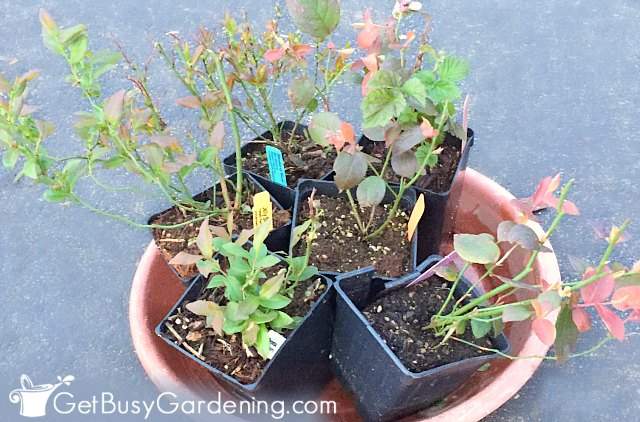
Hardiness Of Blueberry Plants
Blueberries are hardy perennial shrubs that can live for many years in the right climate. Some are only hardy down to zone 5, while others can survive to as cold as zone 3.
The hardiness will depend on the variety you choose, so it’s important to research which ones are best for your zone.
How Do Blueberries Grow?
Blueberry flowers must be pollinated for the plant to produce fruit. Some varieties are self-fertile, while others require another plant for pollination.
However, even the self-fertile types benefit from having a mate nearby. The fruits will be larger, and you’ll get more of them if they are pollinated from another plant.
So, it’s best to buy bushes in groups of two or more, and plant them near each other (rather than scattering them around the landscape).
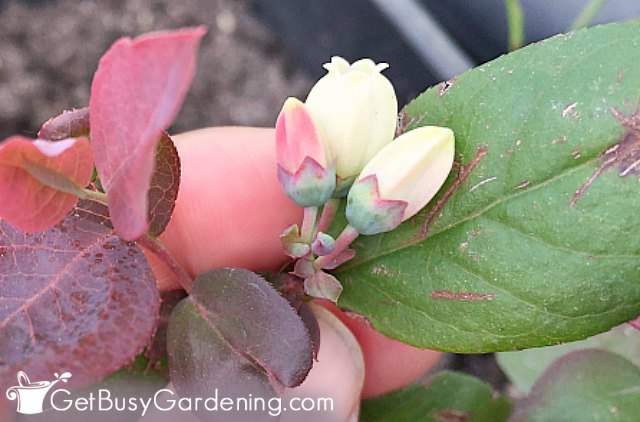
How To Grow Blueberries
Before getting into the specific details of blueberry plant care, it’s important to know where, when, and how to plant them for the best success.
Where To Grow Blueberry Bushes
The best place to grow blueberries is in a full sun location that has rich, well draining soil. They won’t tolerate consistently wet soil, so avoid areas where water pools.
Remember that they can live for many years, so choose a spot where they can stay for the long-term.
Also, be sure you know the mature size of the varieties that you have, so you can give them plenty of space.
Growing Blueberries In Containers
Many varieties also perform very well in containers, which means you can grow them anywhere. So, if your garden is too shady, you can place them on a sunny deck or patio.
Just be sure to choose a smaller variety, such as half-high or dwarf types, for the best results.
These days there are tons of hybrids that are specifically made for growing in containers and small spaces, so you’ll have lots of options.
The most important thing to remember is to always make sure to use a pot with drainage holes, otherwise the containerized blueberry plants won’t survive for long.
You can overwinter the containers in an unheated garage or shed, which is super easy, and works great for mine!
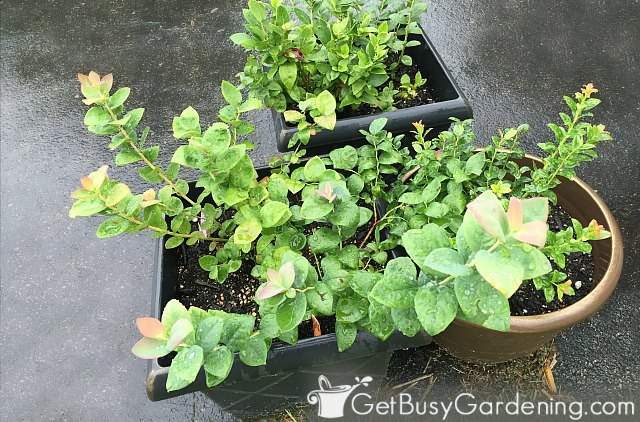
When To Plant Blueberries
The best time to plant blueberries is once the soil is workable in late winter or early spring, and before the heat of summer kicks in.
The second best time to plant them is in the fall, after the temperatures have cooled down. But this is usually best for milder climates, where the winters aren’t too extreme.
How To Plant Blueberries
It’s important to give blueberry bushes adequate space to prevent issues with mildew or disease.
The exact spacing depends on the variety you grow, so be sure to check the plant tag for instructions. But in general, you should space them at least 4-5 feet apart.
Dig a hole that is two times wider and deeper than the rootball. Then plant it at the same depth as it was growing in the pot, taking care not to go any deeper.
Completely cover the roots, then gently pack the soil around the rootball. Finally, cover it with a couple of inches of an acidic mulch, like peat moss, pine needles, or pine bark.
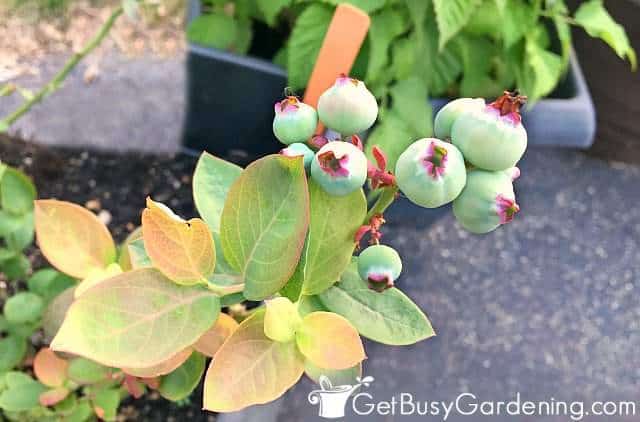
Blueberry Bush Care Instructions
All and all, blueberry plant care really isn’t that difficult. Once you understand what they need to thrive, they’re pretty darn easy to maintain. Here are all the details you need to successfully grow blueberries.
Flowers
Most blueberry varieties get cream or white colored, bell shaped flowers in the spring or early summer. They are not only gorgeous, the bees love them!
First-year blueberry bushes may start blooming shortly after you plant them. However, you should remove the flowers for the first 2-3 years to encourage healthy root and plant growth.
I know it’s a very hard thing to do. But if you allow the plant to set fruit right from the beginning, it can stunt the growth.
So instead, think about the long-term. It’s best to sacrifice a couple of tiny harvests for the first few years, when you will be rewarded with much larger harvests for many years to come.
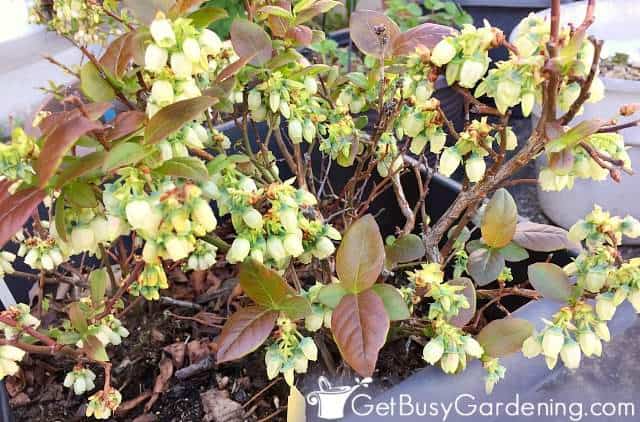
Water
Blueberries prefer consistent and deep waterings. The root system is shallow, so it’s important to keep it moist, and never allow it to completely dry out.
However, it’s equally important to make sure the soil never becomes saturated. They will not survive in soggy soil for very long.
If you struggle with this, then I recommend buying an inexpensive moisture meter to help you get it perfect.
It’s also a good idea to mulch the soil to prevent the top roots from drying out too quickly, which will make the task of watering much easier.
Sunlight
Ideally, it’s best to grow blueberries in full sun. They will do just fine in partial shade, but may not flower as much, or produce very well with less sunlight.
Choose a location that gets 6-8 hours of sunshine a day. If you live in a very hot climate, then it’s a good idea to find a spot where they will be protected from the intense afternoon rays.
Soil
The biggest struggle many people have with growing blueberries is the soil pH. They need acidic soil with a pH of somewhere between 4.0 to 5.0 to thrive.
Alkaline soils must be amended to increase the acidity. Otherwise, it can stunt the plants growth, discolor the leaves, and eventually kill them.
So, before going out and buying plants, the first thing you should do is test your soil. It’s super easy to do with either a home test kit, or simply using a pH probe.
Blueberry plants also need a well draining, loose, soil that is rich in organic matter. So add some compost to improve poor quality soils.
It takes time for amendments to acidify the soil. So, you must do it 3-6 months ahead of time. For best results, amend the soil in the summer or fall before planting blueberries the following spring.
To acidify the soil, mix 4-6 inches of peat moss into the top 6-8 inches of your garden bed. Or use an organic granular sulfur to help lower the pH.
For containers, use an acidic planting mix. Or make your own using peat moss, compost, perlite and vermiculite.
Unfortunately, these amendments won’t last forever. So, you’ll need to monitor the acidity level every few years, and continue to amend the soil as necessary to keep it acidic.
Fertilizer
As I mentioned above, the hardest thing about blueberry plant care is maintaining the soil acidity.
But, as long as you properly amend the soil on a regular basis, then you won’t need to fertilize the plants very often. Usually once or twice per year is sufficient.
Add acidic granular fertilizer before the leaves start budding in the spring, and then again in early summer.
It’s important to apply the granules early, because it takes time for them to break down enough to be used by the plant.
You can also use a liquid acidic fertilizer in the soil and on the leaves a couple of times per month in the spring through summer.
Related Post: How To Make Blueberry Jelly: Easy Recipe
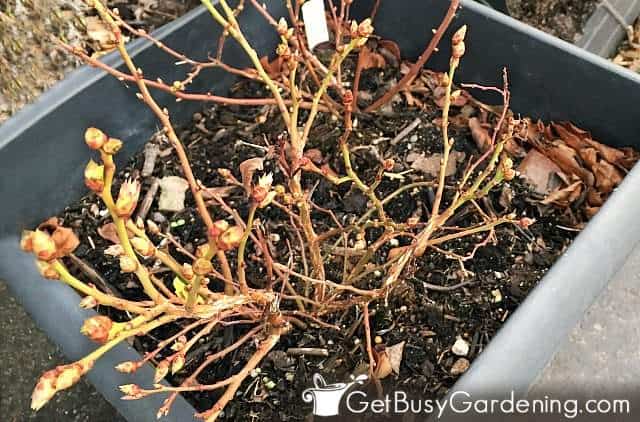
Pest & Disease Control
One of the things that makes growing blueberries such a joy is that they are resistant to most types of pests and diseases.
Japanese beetles can become a problem, and they cause unsightly damage to the leaves. (Though, they have never touched mine.) The best way to control them is to hand pick the adults from the plant.
Other pests, like birds and squirrels, sometimes enjoy snacking on the fruit. If this starts happening, then cover the shrubs with bird netting.
You may also need to protect your plants during the winter, so rabbits won’t eat the stems and branches. I find that putting poultry fencing around mine during the winter is the best solution.
Pruning Blueberry Bushes
Since they are such slow growers, you don’t need to worry about pruning blueberry plants for the first 2-3 years.
Once they are a few years old, prune them annually in early spring before the leaves start growing, but after the extreme cold has passed.
Trimming out the dead, broken, or non-fruiting wood will help to encourage fresh new growth, resulting in better harvests. Be careful that you don’t prune too late, or overdo it, because it could reduce yield.
Tips For Harvesting Blueberries
Baby blueberries are light green in color, then eventually turn the deep blue that we’re all familiar with. They are ready to harvest once they are completely blue.
Fruits can ripen at different times on the same bush, so you can expect to harvest from each plant for a couple of weeks.
To harvest, gently pluck the ripe blueberries from the plant. When they’re ready, they will fall off into your hand at the lightest touch. If they aren’t coming off easily, then wait another day or two before trying again.
Related Post: How To Can Blueberry Jam (With Recipe!)

Propagating Blueberry Plants
Blueberry bushes can be propagated from hardwood cuttings. Take 3-4″ long cuttings from mature plants in the summer.
Dip the cut ends in rooting hormone, and put them into a sandy soil mixture. Then keep them in a warm and moist environment until they form roots. It can take a couple of months for the cuttings to root.
You can also grow them from seeds, but it takes much longer to get a mature plant that way. The seeds can also be very slow to germinate, so be patient.
Troubleshooting Common Problems
The most frustrating part about blueberry plant care is when they start having problems, and you don’t know what’s wrong, or how to fix it.
I’ll give you a hint… most of the problems you’ll have can be traced back to poor quality soil, or the acidity is too low. So, the first thing you should always do is test the pH with a test kit or a pH probe.
Here’s a list of a few of the most common problems you may run into, along with suggested fixes…
Plant Is Slow Or Not Growing
If the soil is not acidic enough, it will stunt the plants growth. So the first thing to do is check the pH, and amend if necessary.
Otherwise, keep in mind that blueberries are naturally slow growing, so this may just be normal for the type you have.
No Fruit
When blueberry bushes don’t set fruit, that is also usually caused by improper soil pH. Test the acidity level, and amend it as necessary.
Plant Is Dying
If your plant is dying, then it’s probably either getting too much water, or the soil is too alkaline. Check the soil moisture level, as well as the pH to make sure it’s ideal.
Leaves Turning Yellow
This is also caused by a problem with the soil, but it’s usually due to a nitrogen deficiency. But again, you must test it to know for sure.
If this is the right diagnosis, then use a high-nitrogen fertilizer to correct the problem.

FAQs About Growing Blueberries
In this section, I will answer some of the most frequently asked questions about blueberry bush care. If you can’t find an answer to your question anywhere here, then ask it in the comments below.
How long does it take for a blueberry bush to bear fruit?
Though blueberry bushes can bear fruit the first year you plant them, it’s best to force them to wait a few years.
Removing the flowers for the first 2-3 years will sacrifice your early harvests. But it will help the plant become established, and result in larger harvests in the future.
Are blueberries hard to grow?
It’s not difficult to grow blueberries, for the most part. However, if you have alkaline soil, it will require extra work to keep it acidic enough to maintain healthy and productive plants. For this reason, many people feel that blueberries are hard to grow.
What month do you plant blueberries?
The best month to plant them depends on where you live. It’s best to plant blueberries in late winter or early spring, before it gets too hot. That’s late April or early May for us here in Minnesota.
Do blueberries need full sun to grow?
Though they will tolerate partial shade, blueberries grow and produce the best in full sun.
Do blueberry plants come back every year?
Yes, they will come back every year as long as you planted a variety that is hardy in your growing zone. Blueberry bushes are perennials that can live for decades in the right environment.
How do you prepare soil for blueberries?
It’s important to first test the pH of your soil. If it is alkaline, then you will need to amend it with peat moss or an organic soil acidifier 3-6 months before planting blueberries. See the “Soil” section above form more specific details.
Growing blueberries isn’t as difficult as you might think. It can take some work, but in the end it’s totally worth it. Follow these plant care instructions, and you’ll be rewarded with loads of fresh blueberries year after year!
If you’d like to learn how to make the most of your space and get as much homegrown food as possible, then my Vertical Vegetables book is perfect! It will teach you all you need to know, has tons of gorgeous photos, and includes 23 DIY projects you can build for your own garden. Order your copy today!
Learn more about my Vertical Vegetables book here.
More About Growing Food
- How To Grow An Avocado Tree
- How To Grow Strawberries
- How To Grow Passion Fruit At Home
- How To Plant Garlic In Your Garden
Share your blueberry plant care tips in the comments section below.






Rebecca says
I purchased two blueberry bushes this year and put them in terra cotta pots on our deck. (So glad I came across your post about blueberries, just wish I had earlier in the season) We live in Northern Ohio and were planning on wintering them either inside the house or in the garage. After reading your post I will probably be wintering them in the garage along with our potted strawberries. Is there any care needing to be done over the winter? Do they need watered? When do you bring them out? What do you do with yours when you do finally bring them out for the season? Thank you.
Amy Andrychowicz says
Yes, the garage is a great spot, and makes it much easier. Blueberries don’t require much care in the winter. I water them well before bringing them in. Then I check the soil every month or so, and if it’s dry, I put some clean snow on top so it slowly waters them as it melts. Keep the soil on the dry side though, be very careful not to overwater. If you have experience keeping your strawberries alive this way, then treat you blueberries the same and you should be good.
Tammy says
I live in southern Florida, and looking for the container variety of blueberries, it does get very hot down here, any special growin instructions on growing in Florida, thanks
Amy Andrychowicz says
In warmer areas like Florida, your local garden center should sell the appropriate varieties of blueberry plants that will do well in your climate. It’s always best to read the plant tag for the best results, but usually in hot climates, blueberries benefit from being protected from the intense afternoon sun. Also, make sure they get plenty of drainage, since you get a lot of rain there. Good luck and have fun!
Lynna says
Does giving the soil coffee grounds help Acidifythe soil?
Amy Andrychowicz says
Though some coffee grounds can be slightly acidic, adding them to the soil doesn’t usually lower the pH very much. And if it does have a noticeable impact on the acidity of the soil, it won’t last long. So, it’s best to stick to using an acidic fertilizer, rather than trying to use coffee grounds for your blueberries.
Nicole says
Thank you! I fenced in my blueberries but they kept dissappearing. I had no idea the birds would go after them. Tomorrow ill be buying netting.
Amy Andrychowicz says
Oh no, sorry to hear the birds have been stealing your blueberries! Netting will definitely help.
Nicole says
It worked! I’m finally getting to eat ripe blueberries.
Amy Andrychowicz says
Awesome, glad to hear it!!
Sarah says
I love blueberries and I LOVED this post. Thanks so much for sharing your expertise and knowledge with us all the time
Amy Andrychowicz says
Wonderful! You’re welcome, and thank you! 🙂
John says
I grow blueberries up in Grand Forks, North Dakota. We’re Zone 4, so it can be done. I actually dug out a large area for them and filled it with peat, acidic soil amendments and most of the pieces and parts of a pine tree that I removed from the yard. I still fertilize every year with an acidic blueberry specific fertilizer and add soil sulfur to keep the ph low. The delicious berries make all the effort worth it. Oh, and make sure to invest in some bird netting. This is a must!! I speak from experience 🙁
Amy Andrychowicz says
Awesome, thanks for adding your blueberry plant care tips. Only one of mine is z4 hardy. I might plant it into the garden eventually, we’ll see.
Paige says
John,
I’m in Dickinson, ND. Last year I bought a couple of bushes while visiting MN and they died withing days of getting home. Due to laziness I left the dead plants (in the containers they came in) on my back steps, then a couple weeks ago something started sprouting in one of the pots, just under the dead plant.. It almost looks like the sprout is coming from between 2 dead stems, if that makes sense? I figured it was a dandelion or some other weed, but as it gets bigger it is looking less like a weed, and Im starting to wonder if its possible that a new bush is growing from it?
Jennie says
I planted blueberries this year. I have 3, Chippewa, Polaris, and I don’t remember what the third kind is, oops! I thought they were hardy in the twin cities. My mother in-law, who is a much better gardener than me, has planted them in the past and they always died. One plant was attacked by bunnies and so we put fencing around them. I have been using a acidic fertilizer every 2 weeks. So far they look good.
Amy Andrychowicz says
Some varieties of blueberries are hardy here, and others are not. Glad to hear yours has recovered from being attacked by the bunnies!
Frank Mosher says
From a long-time high-bush blueberry grower, once a season with acid fertilizer is plenty. Water is what they need most, and netting when they start to turn blue. Cheers from Nova Scotia, Canada, the blue-berry capital of the world! LOL. PS,. Your varieties are excellent!!
Amy Andrychowicz says
Great, thanks for your tips about fertilizing blueberries! I agree that once per year in early spring is adequate.
Tom says
Good for you for trying something new. my Mother-In-Law grows blueberries in Western New York with lots of success! Typically, it’s an area famous for its grape growing abilities, but despite the cold, blueberries grow really well here if they can whether the weather. Sorry about the bad pun! Our biggest issue are the deer who pound them. And the birds as well. So they use nets to keep both away a bit and it’s working. I honestly can’t believe how many blueberries they actually get!
Amy Andrychowicz says
Wonderful! Glad to hear the netting is working to keep both the birds and deer away from your blueberries. Thankfully deer are one pest I haven’t had to deal with for mine.
Cindy says
Hi! We have blueberries here in their own raised bed which made it easier to give them the soil amendments they needed when first planted. Now I fertilize them once a year with organic fertilizer for acid-loving plants. They also have a fence to keep out the rabbits (city garden), who in the hungriest days of winter have been known to eat the blueberry twigs that stick up out of the snow (southern WI, zone 5 but almost 4). I also clip a net over the raised bed when the berries start to turn blue. I like seeing lots of birds in my yard but am not generous enough to share my fruit with them.
But other than those things, they have been really easy!! I have varieties like Friendship, Patriot, hmm, and some with the word blue in them that I can’t remember. None of the varieties you listed, but mine have been really hardy. Wishing you great success with yours. Cindy
p.s. they have lovely fall foliage too.
Amy Andrychowicz says
Yes, I agree that properly amending the soil, and keep the birds and rabbits away are the biggest challenges of growing blueberries. Growing them in raised beds is an excellent idea! Thanks for sharing your experience and tips.